CAPE TOWN'S CHACMA BABOONS
.......now more threatened than ever by first one then another culling protocol
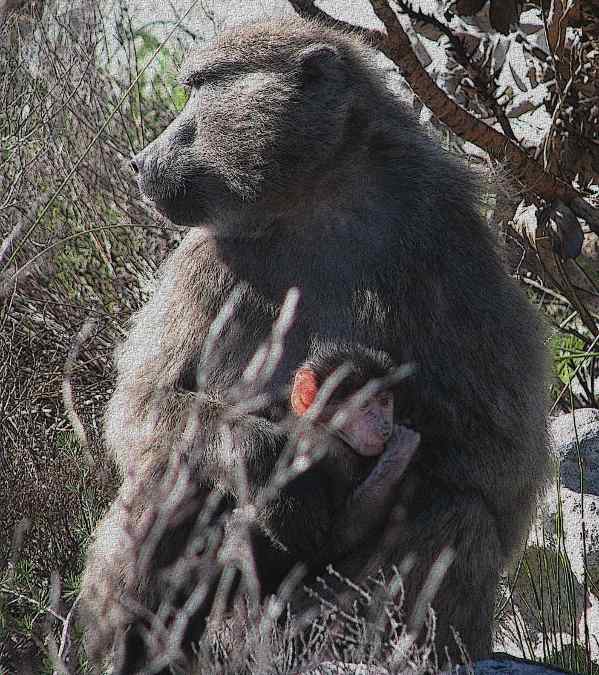

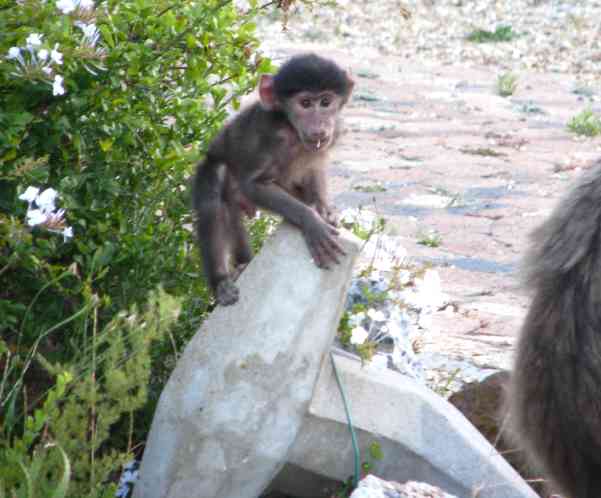

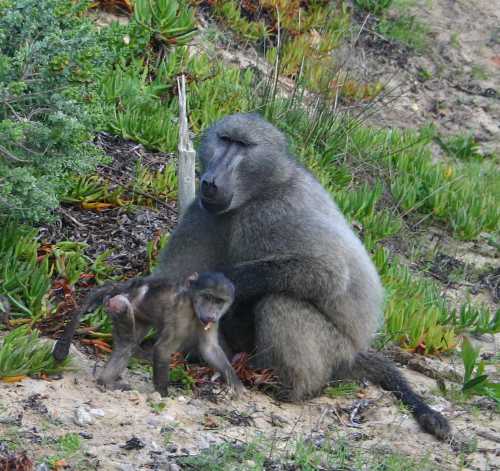
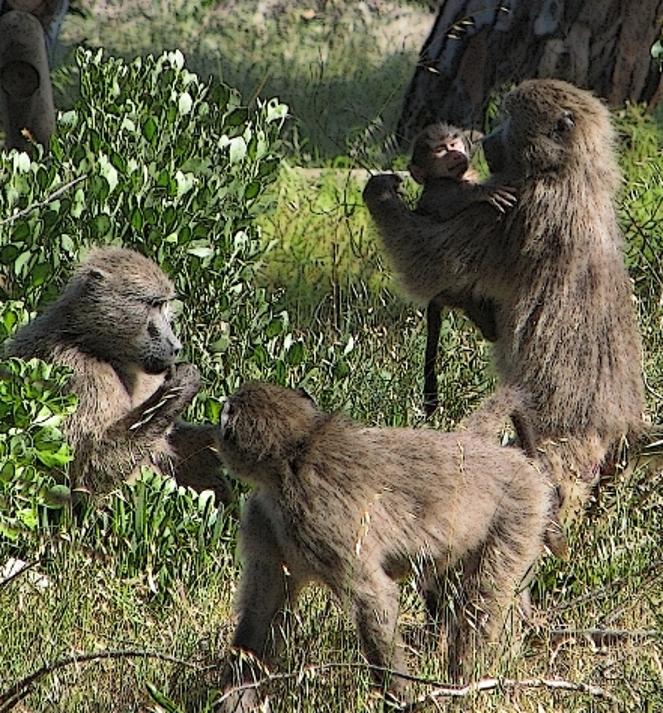
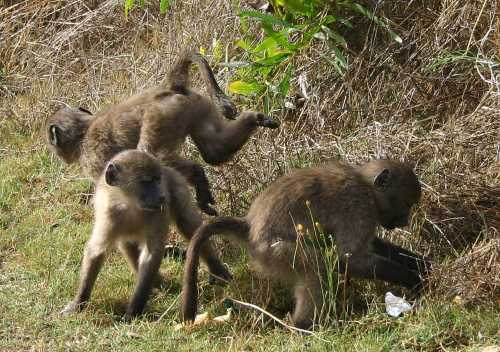
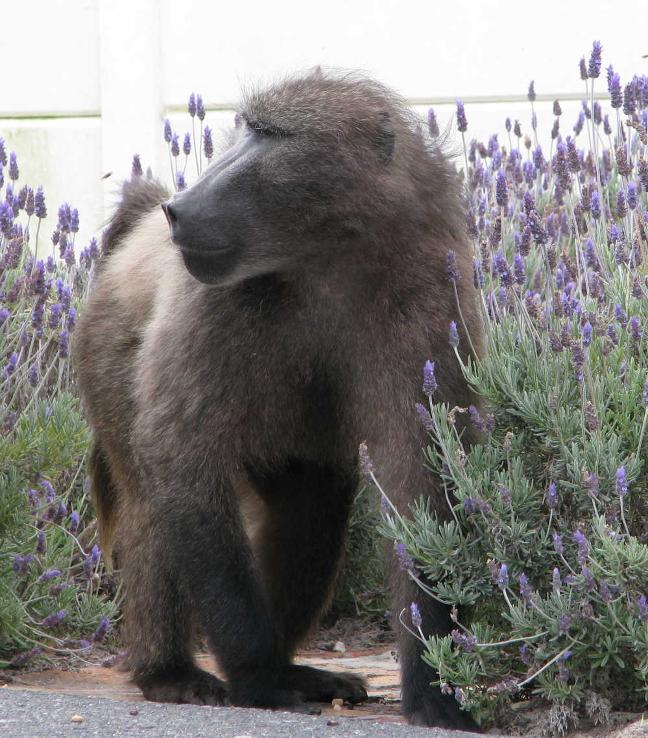

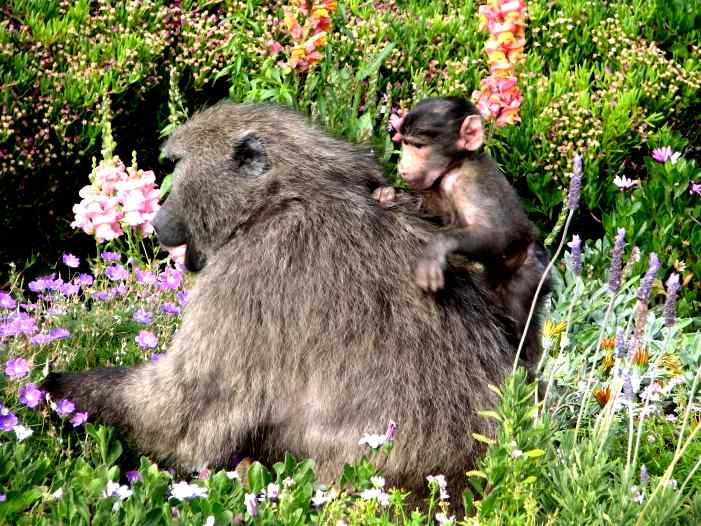
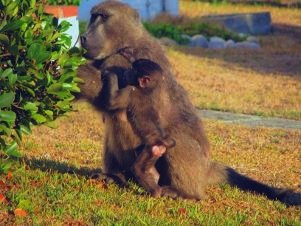
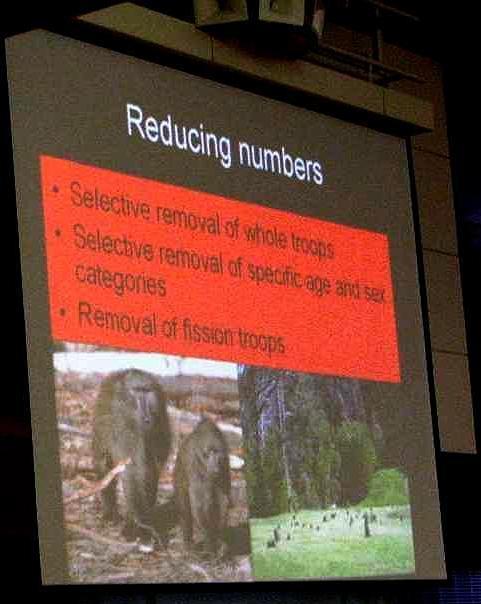
Peninsula visitors enjoy seeing the free- ranging baboons along scenic coastal routes from Simonstown to Scarborough.
Urban development has encroached on their habitat, bringing them into closer contact with their human neighbours, often with fatal results for the baboons.
They pay with life and limb as some residents take illegal action against them. Some residents move into the area but then either refuse or neglect to baboon-proof and become frustrated with baboon raids, blaming baboons rather than taking the proper precautions.
Securing doors, windows and bins helps eliminate food raids and enables other residents to harmoniously co-exist with the animals over numerous years.
Some residents have lobbied for baboons to be totally removed from the urban area but which seems improbable other than culling them or moving them to a sanctuary or reserve.
Although protected by law for more than a decade, with stiff fines in place, few prosecutions have been effected for harming the animals, further encouraging action against baboons.They are whipped, stoned, attacked by dogs, poisoned, ridden over.
Many survivors are riddled with pellets, bullets and birdshot, others are maimed.
While a system of monitors has proven effective in keeping baboons out of human settlements 85% of the time, sustainable funding has been an ongoing problem.
A 3 year government poverty relief grant facilitated by CapeNature ended in September 2008. The City of Cape Town was the sole supplier of funding contributing 3.1 million over 14 months, including the interim 6 month contract expiring at the end of January 2010. The new contract running from 1 Feb-30 June 2010 is jointly funded.
There was a shortage of funding in the first half of 2009 and not all areas had monitors. Consequently baboon presence increased in those areas.
It should be noted that certain residents have long wanted baboons totally removed from the area and during May 2009 some made allegations of baboons being "increasingly aggressive" and posing a potential threat to human safety, demanding the authorities take action.
One woman wrote to CapeNature asking if baboons could be shot in “self defense” as they no longer responded to the recommended jet of hosepipe water.
This may have been her subjective experience but is not true of all. She was quoted in the media as saying “one suggestion is to relocate or cull the more aggressive males.” She became an active supporter of volunteers “chasing” the baboons out the urban area using bull whips and bearbangers.
Cllr Marian Nieuwoudt was a driving force behind the "Baboon Expert workshop" hosted by the City in partnership with CapeNature on 2 July 2009. Changes were made to baboon management following the workshop - including to the monitoring service provider.
Jenni Trethowan of Baboon Matters has shown dedication to the conservation of the baboons over many years, becoming involved after a troop of 18 was shot in 1990 by Cape Nature Conservation (now CapeNature).
The awarding of the interim 6 month contract later in July 2009, by only a select group of the Baboon Management Team (chaired by a CapeNature representative) to another service provider drew allegations of a flawed process, prompting the CEO of the local SPCA together with the husband of a member of the BMT to refer the matter to the Public Protector.
In the first month of the new interim service provider, a controversial "Action plan" was prepared for "Dispersing males and/or repeat raiders" by BRU . A culling protocol, its terms also attempt to override the legally protected status of the baboons.
If residents do not secure bins and houses and if tourists do not lock cars, the opportunistically feeding baboons can be expected to raid unsecured bins and properties, as they will tourists' unlocked cars. If humans are "repeat non-securers" baboons will naturally be "repeat raiders". This is one reason the protocol is so heavily biased against baboons.
In October a cage trap was set for a male whom a shop owner claimed repeatedly raided his premises just metres away from what is considered the baboons' home range.
Like some home owners, the shop owner refuses to baboon-proof the shop, citing "inconvenience".
By using a "repeat raider" category, most of the Peninsula's baboons could be potential candidates for culling even though residents (and tourists) fail to secure property.
Already some young healthy males are tagged and on "death row" on the basis of being so-called "dispersing males" if leaving the troop (particularly if fighting for dominance occurs) and then coming into the urban area. This is difficult to avoid as their home ranges and sleep sites in some areas are separated from urban areas by a street.
Several of those tagged for culling are reported to be dead although it remains difficult to get official confirmation.
Because of terms of the protocol for dispersing males and/or repeat raiders are so broad some believe it allows authorities to remove any baboon they may wish including if complaints are made by residents about baboons being a so-called threat and that this could be misused by those opposing baboon presence to call for baboon removal.
(The dispersing male category is biased against males as they do fight for dominance in a hierarchically based troop structure, giving access to food and females. They may leave the troop for a while so avoiding injuries or they may eventually leave to start their own troop taking one or two females with or may leave to join another troop. Dispersal in these cases is often a lengthy or repeated process which can occur a number of times during the male's life. The protocol attempts to speed up and places unrealistic conditions upon this process. Taking a baboon to another troop with a supposed "vacancy", does not mean he will be permitted to join the hierarchically structured troop but may instead be chased away,)
Bart was the first baboon to be targeted in terms of the protocol. Ironically, he continued to frequent UCT the home of the Baboon Research Unit involved in preparing and endorsing the "Action plan for dispersing males and repeat raiders", criticized by independent scientists and experts as scientifically flawed and biased against the baboons.
Another irony is that the unit counts a digitised map it has prepared as the most significant contribution to the management and conservation of the Peninsula baboons, yet the protocol currently poses the single greatest threat to their existence.
Given what has appeared to be an increase in word and deed against the ostensibly protected baboons over the past months, great concern has been expressed about the future of the animals in both the short and long term, particularly should the City seek to fulfil a mandate of safety accepting the distorted or false claims of some residents who want the baboons removed from the area.
As the 2010 World Cup draws closer, it is a matter of concern that some are attempting to portray baboons as a threat to tourists' safety just as they previously did in relation to residents in order to urge the authorities to take action.
When such claims were first made, the culling protocol was not in place, now it is. The City issued a monitoring tender in November 2009 asking for quotes to "remove, relocate, and/or euthanize" a quantity of dispersing males per month. Regardless of the number in the quote it is of concern that culling on a regular basis is being seen as a management option.
Males form a small portion of the troops, mostly consisting of females and youngsters but play a vital role in the troop including its protection. The new contract began 1 Feb-30 June 2010 and was again awarded to Nature Conservation Corporation whose managing director had stated in 2002 that as a conservationist he would not be involved in killing baboons. Unfortunately, the process of culling baboons has begun.
The photos,show a selection of the remaining baboons of the Cape Peninsula, now more endangered than ever due to management changes and strategies, in particular, the action plan for dispersing males and/or repeat raiders.
NOTE:On June 18, 2010 a "individual raider" protocol was adopted targeting any baboon and although it was claimed to have mitigating circumstances is even more biased against the baboons, effectively overriding their legal protection.
William was the first baboon killed under its terms on 2 July, 2010, the anniversary of the baboon expert workshop
All Content Copyright 2009-2010
All Rights reserved
L Thomas
No portion of content may be reproduced in any way without written permission from author